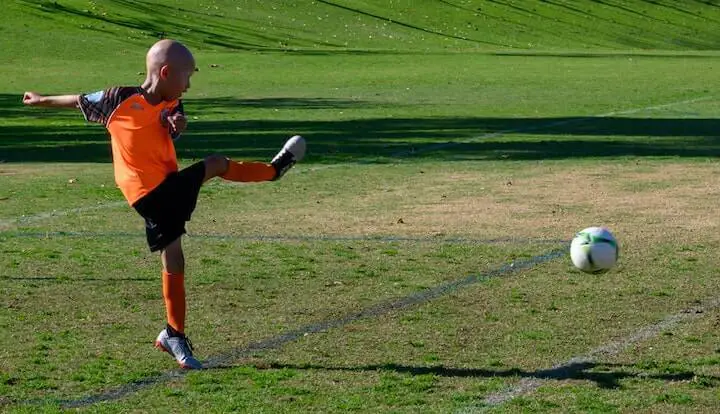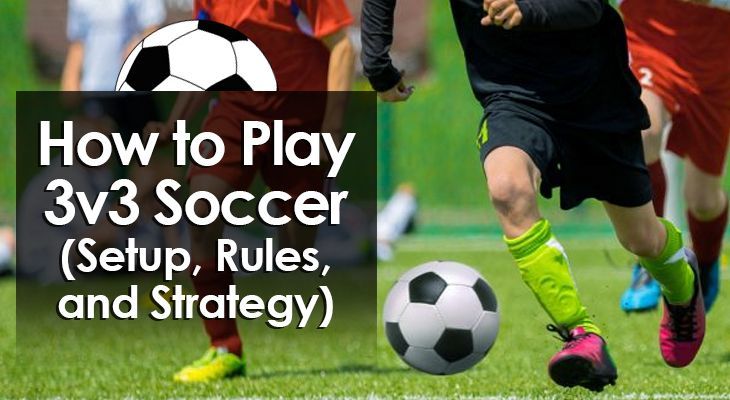How to Play 3v3 Soccer (Setup, Rules, and Strategy)
3v3 soccer is great not only for honing your technique but also for further understanding space, speed, and strategy. And, it's a lot of fun to play!
These "small-sided" games see two teams of three players each.
Unlike traditional matches (11v11), 3v3 soccer sees players constantly switch between playing offense and defense.
Like in basketball, players drop back to defend as soon as soon as they have lost possession or scored a goal.
This makes it a physically demanding sport as players have to constantly attack and defend up and down the pitch.
As each player gets a lot of touches, 3v3 soccer is an increasingly popular game to play.
To help you play and enjoy this fast, frenetic, and fun game, let's take a look at how to set up a match and what rules apply.
The Setup for 3v3 Soccer
Pitch Size:
The typical 3v3 soccer pitch is usually thirty yards wide and forty yards long.
This varies a bit though when the game is played indoors.
In the U6 and U8 age groups, for example, the pitch size further reduced to twenty yards wide by thirty yards long.
Goal Size
The goal also shrink in size and is usually four feet high and six feet wide.
Goal Box Size
When it comes to the goal box directly in front of the goal, the dimensions vary from one league or tournament to another.
The width of the box is usually between 6 to 10 feet with its length ranging from 5 to 8 feet.
These measurements, again, depend on the space available when playing indoors.
Ball Size
While U6 to U8 players usually use a size 3 ball, U9 to U12 often use size 4s with U13 and up using the normal size 5 ball.

The Rules of 3v3 Soccer
As you can imagine, there are quite a few rule differences between standard 11v11 soccer matches on a full-sized pitch and 3v3 soccer games.
These relate to everything from tackling, to offsides, to kick-offs, to throw-ins, and even where you can score from on the pitch.
Two particularly big differences are:
(1) Players of both teams aren't allowed in either goal box
(2) There are no goalkeepers.
To help you setup your own 3v3 match, let's make our way through all the differences in rules.
Take note that unless stated otherwise, all the official FIFA rules apply.
Rule #1 - Players Per Team
Most 3v3 soccer leagues allow each team to have six players on the roster.
Three on the pitch and three on the bench.
Some tournaments, however, increase this up to eight players.
Rule #2 - Substitutions
Substitutions can take place at any dead ball situation.
The players must enter and exit at the halfway line, with the referee's approval.
Players can be subbed on and off as many times as they like (within reason!).
Rule #3 - Game Duration
The length of the match also varies between leagues with most opting to play two halves of ten minutes each.
Alternatively, the game may be decided before the clock runs out if one team goes ten goals ahead.
A match may only end in a tie if it is a pool game, otherwise it goes to overtime.
Rule #4 - Overtime
The teams have three minutes to score a 'golden goal' and win the game.
If after this extra time the teams are still drawing then the tie goes to a penalty shootout.
Each team then takes three spot kicks, rotating through their players.
If it's still tied after that then it goes to sudden death until one team finally scores their penalty without the other team answering them.
Rule #5 - Scoring (in pool play)
In typical league competitions, teams are awarded three points for a win, one for a draw, and none for a loss.
If a team fails to show up for a match or are more than five minutes late then they forfeit the match and are awarded a 5-0 loss.
Rule #6 - Kick-off
Every kick-off may be kicked in either direction.
They cannot, however, score directly from one.
Rule #7 - Throw-In / Kick-In
Players are prohibited from using their hands to throw the ball back in to play after it's gone out.
Instead, players kick in from where it went out along the touchline.
Rule #8 - Five-Yard Rule
In dead-ball situations, all opposing players must stand at least five yards away from the ball.
If the defending team's goal area is closer than five yards then the ball placement is adjusted.
In these situations, the ball should be five yards from the goal area, in line with where the foul occurred.
Rule #9 - Indirect Free-Kicks
All dead-ball kicks (kick-ins, goal kicks, free kicks and kick-offs) are indirect.
The only exceptions are corners and penalties.
Rule #10 - Goal Kicks
Goal kicks can be taken anywhere along the goal line, except from within the goal box.
Rule #11 - Penalty Kicks
Penalty kicks are taken from the centre circle of the pitch, even for penalty shootouts.
All other players must be behind the halfway line when during penalty kicks.
If the penalty kick takes place during the match, and the player misses the goal, a goal kick is instead awarded to the opposition.
The referee awards penalty kicks if a team commits an infraction that prevents a goalscoring opportunity.
Rule #12 - Handballs
Deliberately handling the ball to prevent clear goal-scoring opportunity results in a penalty.
The offending player receives a red or yellow card, at the referee's discretion.
Rule #13 - Heading
Heading is not allowed in 3v3 soccer.
If a player deliberately heads the ball, the opposing team gets an indirect free kick.
The free kick takes place from where the infraction occurred.
Rule #14 - Slide Tackling
Likewise, slide tackling is not permitted in 3v3 soccer.
If a player does slide in on an opponent, they give away a free kick and are liable for a red or yellow card.
Players are only allowed to slide when intercepting the ball or preventing it from going out of bounds.
Rule #15 - Offsides
In addition to heading and slide tackling, there are also no offsides in 3v3 soccer.
Rule #16 - Yellow and Red cards
As with normal soccer, players can receive a yellow or red card for a variety of different reasons.
Such reasons include dissent, handling the ball, committing a bad foul, or wasting time.
Players who receive two yellow cards in a game will of course receive a red card and are expelled from the game.
Red cards mean they may also miss their next game.
Teams continue playing with just two players if they do receive a red card.
Coaching staff and players on the bench may also be awarded cards, at the referee's discretion.
Rule #17 - Goal Box
As mentioned earlier, each goal has a box before it that is roughly six feet wide by six feet long.
While players are permitted to pass through it, they are NOT allowed to touch the ball while inside the box.
This means that teams play without a goalkeeper.
If the ball stops within the box, the defending team is awarded a goal kick regardless of who touched it last.
A goal is awarded to the opposition if a defender touches the ball within in the goal box
If, however, an attacker touches the ball within the box, a goal kick is awarded to the defending team instead.
Rule #18 - Goal scoring
A goal may only be scored from within the team's offensive half of the pitch.
This means that teams cannot score with a direct shot from the halfway line or from within their own half.
If they do happen to score directly from their defensive half, they are not given a point.
A goal kick is instead awarded to the opposition team.
If a defensive player kicks the ball across the halfway line and the ball hits another player before scoring, then the goal stands.
Strategies for 3v3 Soccer
Strategies here are very different, given all the changes in rules, setup, and gameplay.
Although coaches draw up all kinds of plays, let's take a look at some key strategies you can use to help your team succeed.
Defending in 3v3 Soccer
V-Shape formation
Most teams line up in a 'V' shape with one player staying further back and the other two positioned forward.
When defending, the last player ideally always stays between the goal and the ball.
When in possession, the team should be careful not to lose the ball as this leaves them open to counterattacks -- one of the most common ways to score in the game.
High press
While some teams like to press high and have all three players forward, this does have its risks.
Opposing players can either trick or pass their way in for an easy score.
Zone defense
Most teams retreat when they lose the ball with each player defending a different "zone" or area.
The idea is that while one defender covers the ball, the other two mark the opposing players.
The other two defenders will also help by playing the passing lanes.
This system allows you to contain the opposition and wait for the right time to take back control of the ball.
Communication is crucial as players constantly switch covers to defend rotating attackers.
It is a good idea to have the two forward players defend the middle are of the pitch.
This forces the attacking players out wide, giving them less space to operate.
Attacking in 3v3 Soccer
When defense leads to offense
Due to the faster pace and smaller goals, defending well is one of the best forms of attack.
Many goals come from counter attacks or quick transitions after a successful defense.
A strong defense often leaves the opposing players out of position to defend a devastating counter attack.
As such, patience is essential and this holds true for both defending and attacking.
Attackers need to probe away at the defense, rotating here and there, until the right opportunity to strike arises.
Pass and go
Another way to get around opponents and score goals is through quick precision passing and constant movement.
Even after making a pass, the player keeps moving and works towards getting open for the next pass.
By whizzing the ball about, creating passing triangles and moving into space, you can drag opponents out of position.
This opens up their defense, giving your team shooting opportunities.
Dribble around the defense
Dribbling is a good way to open up space and create numerical advantages out on the pitch.
You want to choose your battles wisely to avoid handing the initiative to your opponent.
Dribbling tricks and moves with quick bursts of speed can help you get around an opponent and in position to score.
Conclusion
Although played in smaller spaces and with a different set of rules, 3v3 soccer is great for all players -- pros and amateurs alike.
With the much quicker pace, it will definitely help improve your fitness and stamina.
The game also helps develop all kinds of skills...
From passing and scoring, to attacking and defending.
It also allows you to work on 'off-ball' skills like teamwork, reading the opposition, and moving without the ball.

